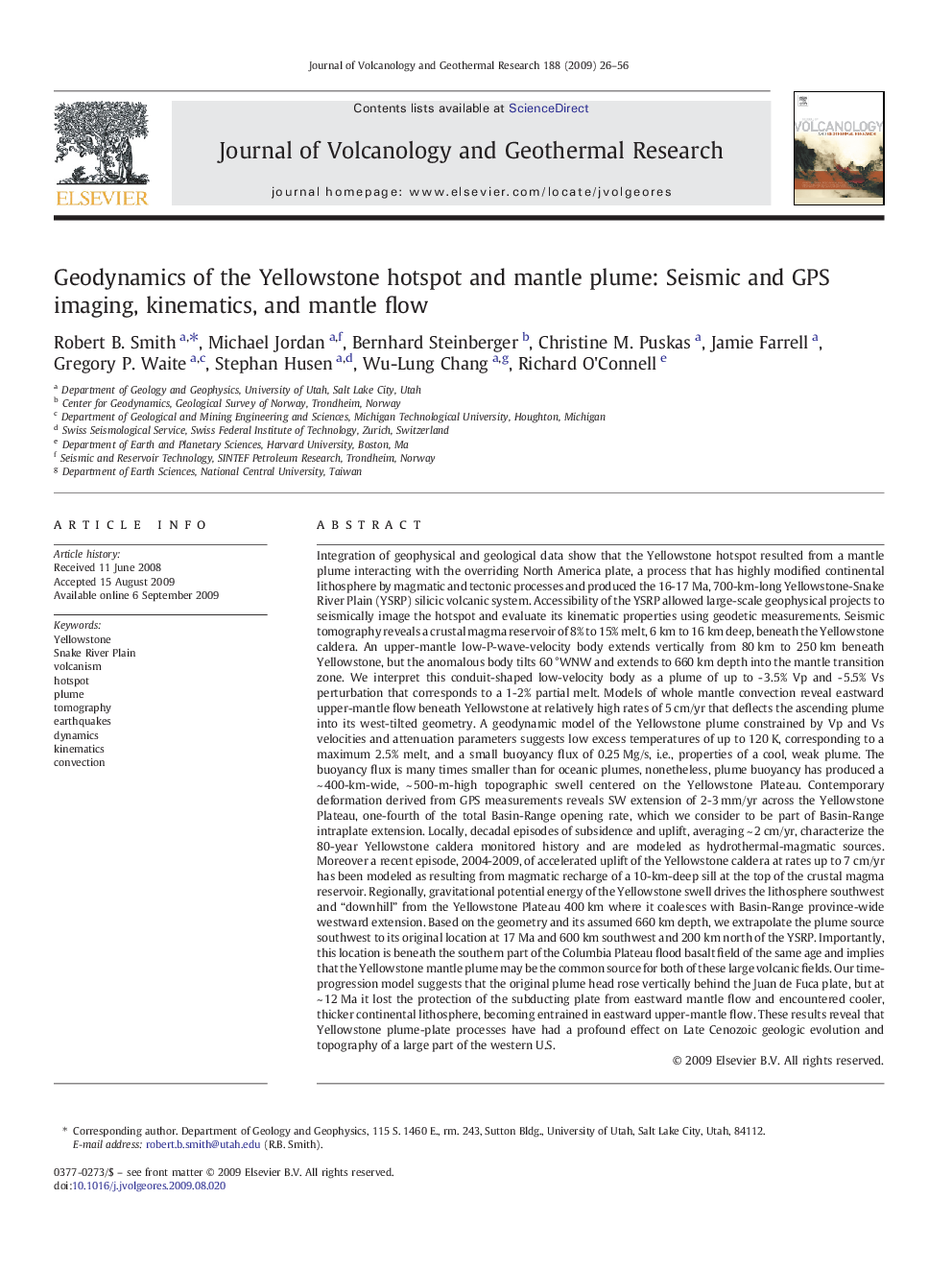| کد مقاله | کد نشریه | سال انتشار | مقاله انگلیسی | نسخه تمام متن |
|---|---|---|---|---|
| 4713168 | 1638428 | 2009 | 31 صفحه PDF | دانلود رایگان |

Integration of geophysical and geological data show that the Yellowstone hotspot resulted from a mantle plume interacting with the overriding North America plate, a process that has highly modified continental lithosphere by magmatic and tectonic processes and produced the 16-17 Ma, 700-km-long Yellowstone-Snake River Plain (YSRP) silicic volcanic system. Accessibility of the YSRP allowed large-scale geophysical projects to seismically image the hotspot and evaluate its kinematic properties using geodetic measurements. Seismic tomography reveals a crustal magma reservoir of 8% to 15% melt, 6 km to 16 km deep, beneath the Yellowstone caldera. An upper-mantle low-P-wave-velocity body extends vertically from 80 km to 250 km beneath Yellowstone, but the anomalous body tilts 60 °WNW and extends to 660 km depth into the mantle transition zone. We interpret this conduit-shaped low-velocity body as a plume of up to - 3.5% Vp and - 5.5% Vs perturbation that corresponds to a 1-2% partial melt. Models of whole mantle convection reveal eastward upper-mantle flow beneath Yellowstone at relatively high rates of 5 cm/yr that deflects the ascending plume into its west-tilted geometry. A geodynamic model of the Yellowstone plume constrained by Vp and Vs velocities and attenuation parameters suggests low excess temperatures of up to 120 K, corresponding to a maximum 2.5% melt, and a small buoyancy flux of 0.25 Mg/s, i.e., properties of a cool, weak plume. The buoyancy flux is many times smaller than for oceanic plumes, nonetheless, plume buoyancy has produced a ~ 400-km-wide, ~ 500-m-high topographic swell centered on the Yellowstone Plateau. Contemporary deformation derived from GPS measurements reveals SW extension of 2-3 mm/yr across the Yellowstone Plateau, one-fourth of the total Basin-Range opening rate, which we consider to be part of Basin-Range intraplate extension. Locally, decadal episodes of subsidence and uplift, averaging ~ 2 cm/yr, characterize the 80-year Yellowstone caldera monitored history and are modeled as hydrothermal-magmatic sources. Moreover a recent episode, 2004-2009, of accelerated uplift of the Yellowstone caldera at rates up to 7 cm/yr has been modeled as resulting from magmatic recharge of a 10-km-deep sill at the top of the crustal magma reservoir. Regionally, gravitational potential energy of the Yellowstone swell drives the lithosphere southwest and “downhill” from the Yellowstone Plateau 400 km where it coalesces with Basin-Range province-wide westward extension. Based on the geometry and its assumed 660 km depth, we extrapolate the plume source southwest to its original location at 17 Ma and 600 km southwest and 200 km north of the YSRP. Importantly, this location is beneath the southern part of the Columbia Plateau flood basalt field of the same age and implies that the Yellowstone mantle plume may be the common source for both of these large volcanic fields. Our time-progression model suggests that the original plume head rose vertically behind the Juan de Fuca plate, but at ~ 12 Ma it lost the protection of the subducting plate from eastward mantle flow and encountered cooler, thicker continental lithosphere, becoming entrained in eastward upper-mantle flow. These results reveal that Yellowstone plume-plate processes have had a profound effect on Late Cenozoic geologic evolution and topography of a large part of the western U.S.
Journal: Journal of Volcanology and Geothermal Research - Volume 188, Issues 1–3, 20 November 2009, Pages 26–56